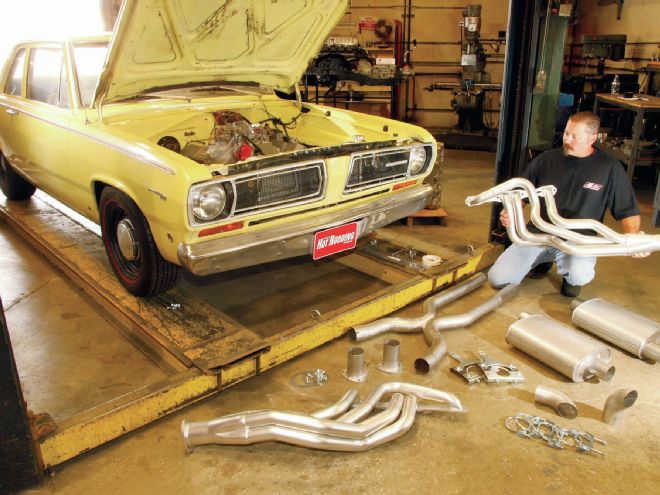
The idea sounded simple enough: build a massively powerful low-deck Chrysler wedge with a stock-location exhaust port, then drop it into our '68 Plymouth Valiant A-Body. Logic dictated that would be the easiest route, but we found out otherwise. The root of our problem—if you could call it that—is that our 500ci Indy-built low-deck wedge made so much power through Indy's EZ-1 cylinder head that no A-Body header on the planet was capable of moving that kind of exhaust flow. Until the introduction of Indy's lineup of EZ-1 cylinder heads, making anything north of 550 hp with a stock-location 383/400 exhaust port was simply unheard of. In spite of the low-deck wedge's designation as a big-block, in stock form it is for all intents a small-block, and is well-served—even in breathed-on form—by the existing 1.75-inch header market.
When the cylinder head aftermarket finally began servicing the B/RB engine family with high-flowing heads, it was almost exclusively with raised exhaust ports, and most header manufacturers followed suit. A-body long-tube headers with primary tube diameters of 1.875-, 2-, and even 2.125-inch sizes are all available, but they all share the same trait: they're for a raised exhaust port. But then Indy came out with their game-changing EZ cylinder head program, which amped up the power with Max Wedge–sized intake runners—and more interestingly, exhaust ports in the stock location. We jumped on the idea, and had Indy build us a 500ci low-deck wedge using their aluminum Indy Maxx block and EZ-1 cylinder heads. With an aluminum Mod Man intake, a dual-quad Edebrock carb setup, and a COMP mechanical cam, it belted out 657hp at 6,100 rpm and a rotund 662 lb-ft of torque at 4,500 rpm, all through a 2.125-inch dyno header.
By the time we dropped the Indy Maxx into our '68 Valiant, we had discovered our three existing header choices, and they were all unacceptable. 1). Use a small 1.75-inch header or exhaust manifold and kill something north of 100 hp. 2). Use a set of 2-inch diameter fenderwell headers, butcher the inner fenders, and use skinny front runners to keep the tires from rubbing. Or 3). Build a set of freakishly expensive custom headers and try to convince readers they could somehow do this themselves.
Meanwhile, the folks at Indy and TTI had been contemplating the same thing. They had come to the same conclusion as us because Indy Cylinder Heads sent an Indy Maxx low-deck block and a set of EZ-1 cylinder heads to TTI for them to play with. The collaboration of these two companies should come as no surprise, with Indy being known for its high-performance Chrysler-based crate engines and components, and TTI being acknowledged for its class-leading Mopar-specific headers and exhaust systems. And while other companies certainly make some great hardware, both of these players are deeper into the Chrysler market than any of their respective competitors. It's literally a matter of survival that they put out the best Chrysler-based products possible.
The root of our problem … no A-Body header on the planet was capable of moving that kind of exhaust flow.
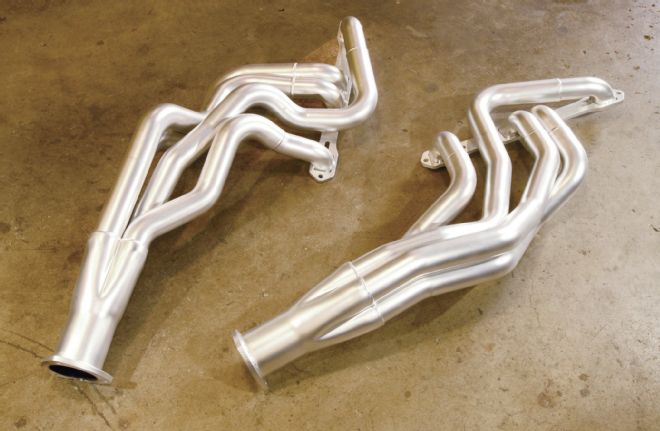
We went into our '68 Valiant Project blind, not realizing that nobody made a large-diameter header for a low-deck big-block in a '67-76 A-Body with a stock location exhaust port. Then TTI came to the rescue with these pipes! TTI's 2-into-2.125-inch long-tube step headers (PN 400SR-218) will also fit '62-74 B-Body, and '70-74 E-Body.
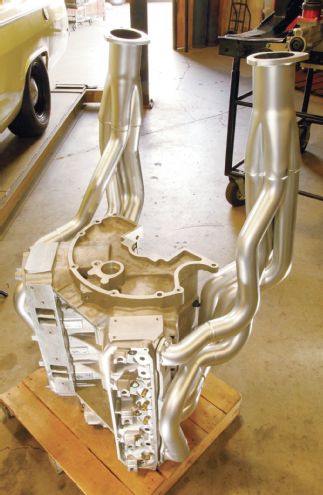
Our '68 Valiant headers also stipulated that they play nice with Indy's aluminum Maxx block, which has wider pan rails and upgraded cross-bolted mains. The scene here at TTI's Corona, CA manufacturing facility depicts an Indy Maxx block with Indy EZ-1 cylinder heads mocked up with TTI's long-tube headers. Note how close the tubes pass to the block pan rails and main cap fasteners.
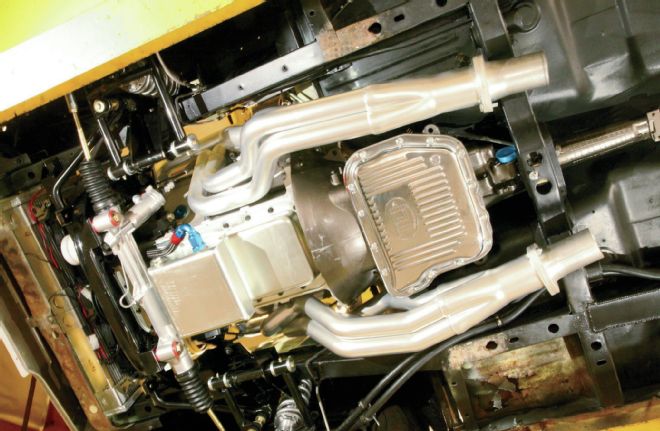
Mike Davis is the brains behind all new header projects at TTI. He designs, mocks up, and fabricates all of TTI's prototype headers and manufacturing fixtures, and this stock-port long-tube step header is his most recent baby. We threw Mike into the deep end of the pool, where he installed a final production set of 2-into-2.125-inch long-tube headers and exhaust into our '68 Valiant with us rolling video and taking photos. The operation took him just two hours, and there were no surprises with bolts, spark plugs, starters, steering components, or strenuous sessions with prybars!
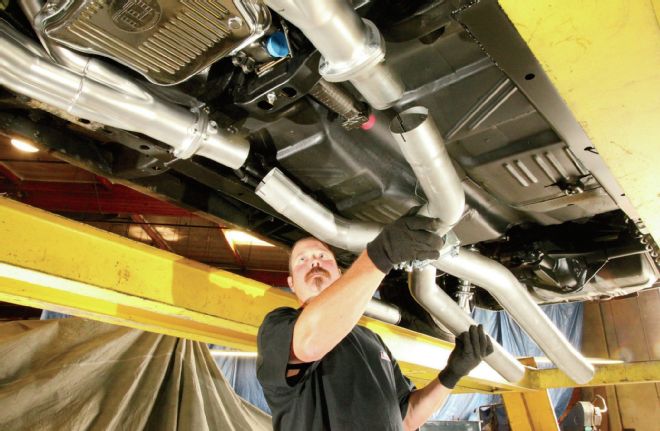
A big-block in an A-Body usually translates into having little or no room to access header bolts or spark plugs, and other than the No. 6 plug (second from the rear, passenger side) having to go in from below the car with a drive extension, the install was cake. Tip: Taping up the primaries with masking tape will protect the ceramic finish during installation.
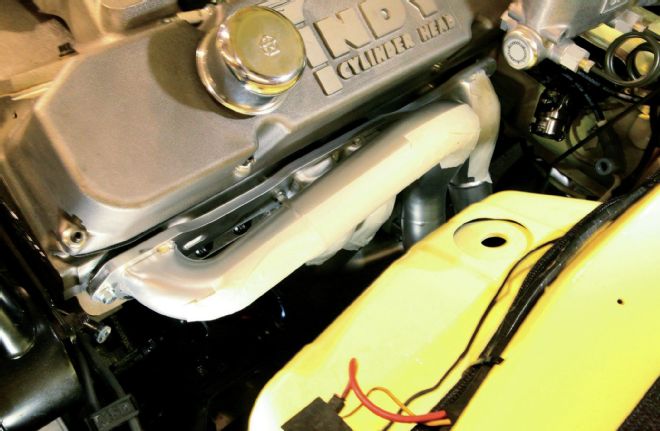
On the driver side, note how the steering linkage of our RMS rack-and-pinion conversion has been removed to facilitate installation. If your steering is stock, the steering column and linkage can stay in place. With a stock steering set-up, you'll need to remove the starter, install the header, then bolt the starter back up. Once again, there's plenty of room to install 3/8-inch header bolts and plugs.
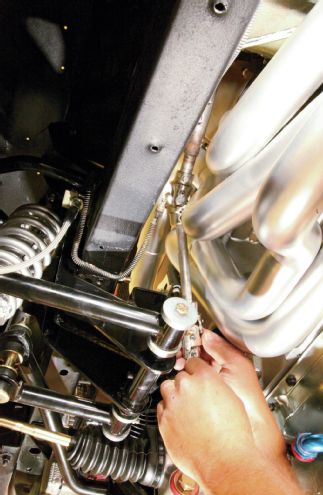
Here you can see the steering linkage for the Reilly Motorsports rack-and-pinion going back in after the driver-side header is in place.

These reducers channel the 3.5-inch header collectors into a 3-inch pipe, and also have provisions for oxygen sensors. We'll be needing those down the road when we tweak our dual-quad Edelbrock carb setup on the dyno. Note how the headers clear the pan on our TCI Streetfighter 727 trans.
When TTI "plays with" parts like Indy sent, they don't mess around. They got busy right away mocking them up in an A-Body front clip, bending some custom large-diameter pipes. TTI's decision to spec out a 2-into-2.125-inch stepped primary was based on the need to cover the largest of Indy's EZ heads—the 325cc, 370-cfm–capable, CNC-ported "Big Easy." This can be used on Indy low-deck crate engines up to 500 ci that when equipped with the "Big Easy" head can make power well over 800 hp on premium pump gas. Better yet, when other cylinder head makers step up to the plate with a wicked wedge head with a stock location exhaust port, the need for an A-Body header will already be met.
By the time we called TTI, we had our logic worked out and our speech prepared. Fortunately, TTI was already two steps ahead of us. They already had the headers designed and built, and they wanted to know if we'd be willing to give up our '68 Valiant as a mule for test-fitting the production components. Our wish list was apparently already handled, so it was simply a matter of towing the Valiant over to TTI's Corona facility, and seeing for ourselves if the fit and finish was up to standards.
When we got to TTI, what we found was a well-organized operation that had the subject headers already prepped with the satin-ceramic coating we requested. These headers were comprised of mandrel-bent mild-steel tubes built on TTI's final production tooling jigs and welded to TTI's laser-cut 3/8-inch-thick flanges. Like all TTI production headers, they had been hand-finished for maximum flow at the exhaust port, and all primaries were built with a 1/8-inch expansion step in them at the midway point, a proven design that fattens the torque curve incrementally. We also opted for some 3-bolt, 3.5-to-3-inch reducers with O2 fittings, and a dual 3-inch X-pipe exhaust with Dynomax Super Turbo mufflers and axle turndown tips. We got to see firsthand both the A-Body mock-up fixture that TTI used to prototype the headers, as well as the aluminum Indy Maxx block and cylinder heads that Indy had sent over. In spite of these TTI headers being the first production pieces ever bolted to a real car, it only took a couple hours to get the entire system bolted on. That's a testament to how well the team at TTI designs their headers. Let's take a closer look now at how it all went down!
What To Get! Description: PN: Cost: 2- to 2.125-inch long-tube step headers, coated 400SR-218-C4 $892.00 3-inch X-pipe XA30-MP $296.00 3.5- to 3-inch header reducers RED35X30X6 $53.00, pair 3-inch Dynomax Super Turbo mufflers DYN 17793 $235.10, pair Muffler hangers MH-A30HA $75.00 pair 3-inch exhaust turndowns TIP30-TD $37.00 pair Total: $1,588.10
This money shot shows how nicely the TTI headers clear everything. Although we have an RMS AlterKtion front suspension, note that the TTI pipes also work with the factory suspension, stock torsion bars, and factory steering. You can also make out the proximity of the header primary to the engine block. TTI dimpled the passenger-side header in one place and the driver side in two places in order clear the cross-bolted main fasteners on the pan rail. If you've got an Indy Maxx block, you will need to request this service in advance. OE "B" blocks will not need this prep.
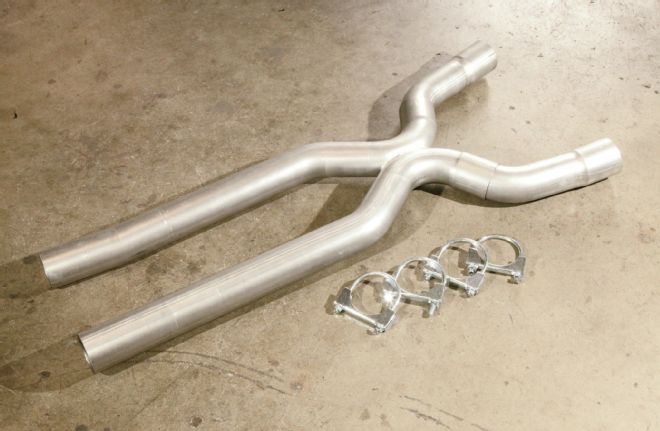
TTI also offers complete exhaust systems for most Mopars. Due to our Street-Lynx four-link rear suspension, we ordered off the TTI menu a la carte. This 3-inch X-pipe system uses slip-fit, mandrel-bent tubing with U-clamps for easy installation, and costs $296.

The 3-inch X-pipe system was pre-assembled, and slipped right on with only minor adjustment. An X-pipe like this is proven to maximize power at the wheels due to its unique scavenging advantage over a straight, dual-pipe arrangement or even an "H" balance tube.
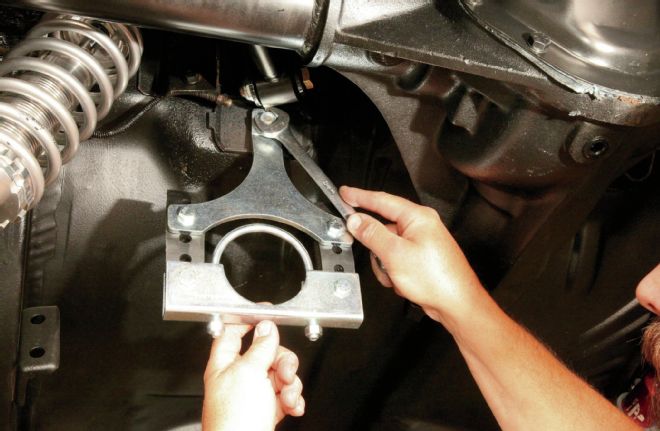
We used two TTI exhaust hangers, one on each of the two rear seatbelt anchor studs. The stock anchor studs were removed and replaced with ones long enough to accommodate the additional thickness of the hanger.
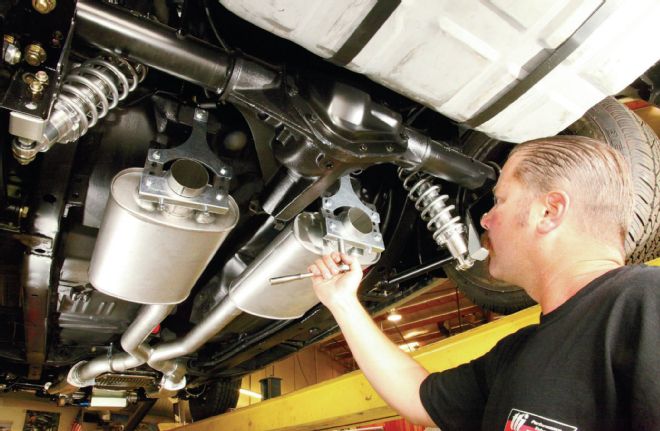
Dynomax Super Turbo mufflers give any hot rod a very distinctive rumble, and they are among the best at preserving the system flow and horsepower of a high-performance V-8. Our dual 3-inch system will end at the axle because the combination of a Dana-style rearend and RMS Street-Lynx four-link suspension does not provide ample clearance for an over-axle system. Even if it had though, we would've chosen axle turndowns for the fabulous sound!
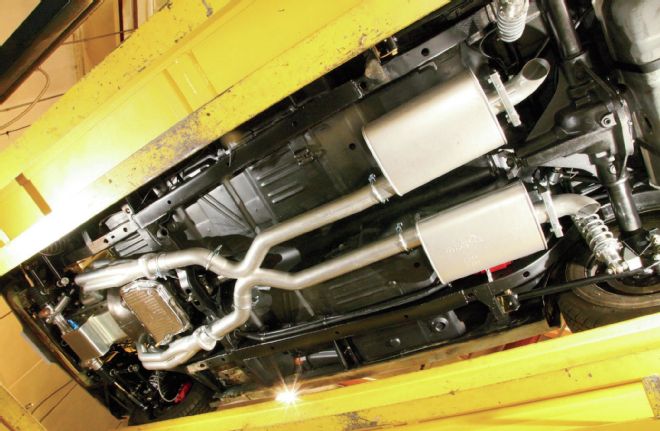
The last thing to add was a pair of 3-inch turndown tips, which we angled to outflow directly in front of the rear tires. This will provide spectacular clouds of billowing tire smoke during burnouts! With the exhaust positioned correctly and the clamps aligned over their respective unions, the whole system was tightened up. Want to see more? Go to the TTI website (www.TTIExhaust.com), and watch our videos on both the installation, and how TTI builds headers.